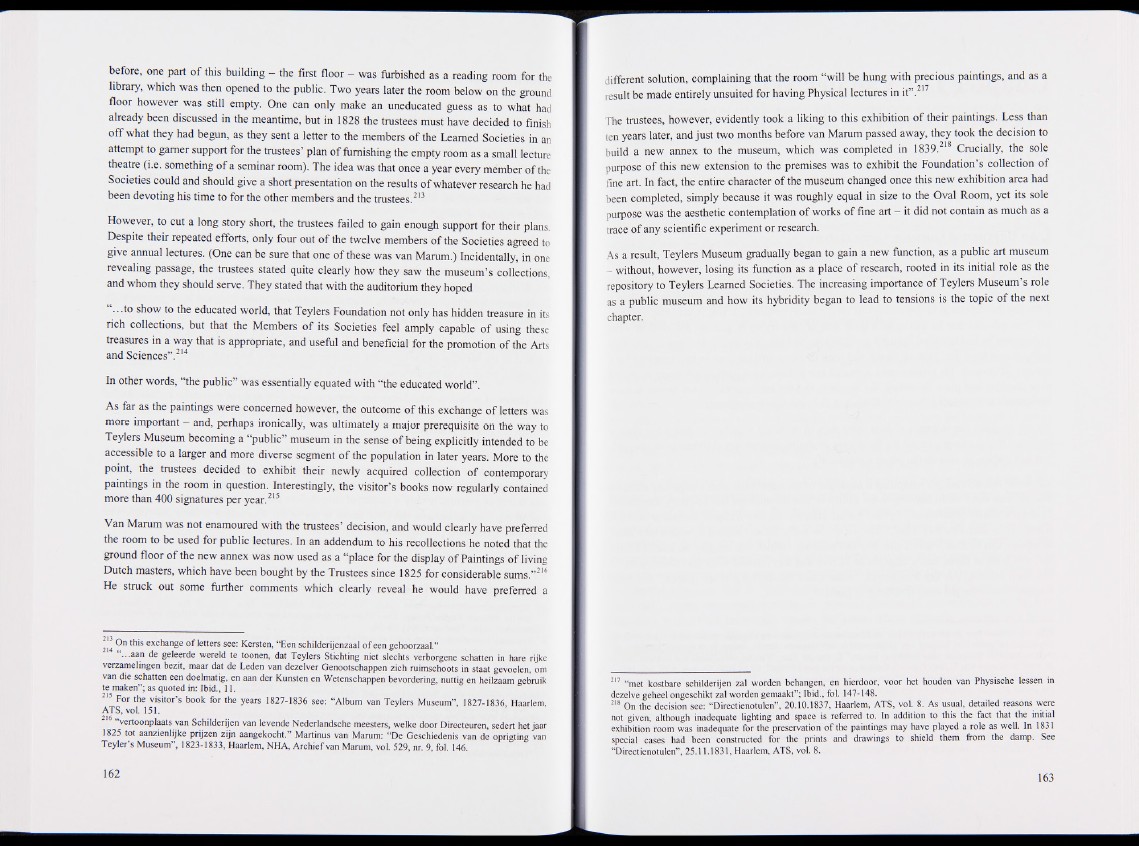
before, one part of this buildings the first floor 8 was furbished as a reading room for the
library, which was then opened to the public. Two years later the room below on the ground
floor however was still empty. One can only make an uneducated guess as to what had
already been discussed in the meantime, but in 1828 the trustees must have decided to finish
off what they had begun, as they sent a letter to the members of the Learned Societies in an
attempt to gamer support for the trustees’ plan of furnishing the empty room as a small lecture
theatre (i.e. something of a seminar room). The idea was that once a year every member of the
Societies could and should give a short presentation on the results of whatever research he had
been devoting his time to for the other members and the trustees.213
However, to cut a long story short, the trustees failed to gain enough support for their plans.
Despite their repeated efforts, only four out of the twelve members of the Societies agreed to
give annual lectures. (One can be sure that one of these was van Marum.) Incidentally, in one
revealing passage, the trustees stated quite clearly how they saw the museum’s collections,
and whom they should serve. They stated that with the auditorium they hoped
“...to show to the educated world, that Teylers Foundation not only has hidden treasure in its
rich collections, but that the Members of its Societies feel amply capable of using these
treasures in a way that is appropriate, and useful and beneficial for the promotion of the Arts
and Sciences”.214
In other words, “the public” was essentially equated with “the educated world”.
As far as the paintings were concerned however, the outcome of this exchange of letters was
more important — and, perhaps ironically, was ultimately a major prerequisite on the way to
Teylers Museum becoming a “public” museum in the sense of being explicitly intended to be
accessible to a larger and more diverse segment of the population in later years. More to the
point, the trustees decided to exhibit their newly acquired collection of contemporary
paintings in the room in question. Interestingly, the visitor’s books now regularly contained
more than 400 signatures per year.215
Van Marum was not enamoured with the trustees’ decision, and would clearly have preferred
the room to be used for public lectures. In an addendum to his recollections he noted that the
ground floor of the new annex was now used as a “place for the display of Paintings of living
Dutch masters, which have been bought by the Trustees since 1825 for considerable sums.”216
He struck out some further comments which clearly reveal he would have preferred a
On this exchange o f letters see: Kersten, “Een schilderijenzaal o f een gehoorzaal.”
...aan de geleerde wereld te toonen, dat Teylers Stichting niet slechts verborgene schatten in hare rijke
verzarnelingen bezit, maar dat de Leden van dezelver Genootschappen zieh ruimschoots in staat gevoelen, om
van die schatten een doelmatig, en aan der Künsten en Wetenschappen bevordering, nuttig en heilzaam gebruik
te maken”; as quoted in: Ibid., 11.
215 For the visitor’s book for the years 1827-1836 see: “Album van Teylers Museum”, 1827-1836, Haarlem,
ATS, vol. 151.
“vertoonplaats van Schilderijen van levende Nederlandsche meesters, welke door Directeuren, sedert het jaar
1825 tot aanzienlijke prijzen zijn aangekocht.” Martinus van Marum: “De Geschiedenis van de oprigting van
Teyler’s Museum”, 1823-1833, Haarlem, NHA, Archief van Marum, vol. 529, nr. 9, fol. 146.
different solution, complaining that the room “will be hung with precious paintings, and as a
result be made entirely unsuited for having Physical lectures in it”.21
The trustees, however, evidently took a liking to this exhibition of their paintings. Less than
ten years later, and just two months before van Marum passed away, they took the decision to
build a new annex to the museum, which was completed in 1839.218 Crucially, the sole
purpose of this new extension to the premises was to exhibit the Foundation’s collection of
fine art. In fact, the entire character of the museum changed once this new exhibition area had
been completed, simply because it was roughly equal in size to the Oval Room, yet its sole
purpose was the aesthetic contemplation of works of fine art - it did not contain as much as a
trace of any scientific experiment or research.
As a result, Teylers Museum gradually began to gain a new function, as a public art museum
- without, however, losing its function as a place of research, rooted in its initial role as the
repository to Teylers Learned Societies. The increasing importance of Teylers Museum’s role
as a public museum and how its hybridity began to lead to tensions is the topic of the next
chapter.
217 “met kostbare schilderijen zal worden behängen, en hierdoor, voor het houden van Physische lessen in
dezelve geheel ongeschikt zal worden gemaakt”; Ibid., fol. 147-148.
218 On the decision see: "Directienotulcn", 20.10.1837, Haarlem, ATS, vol. 8. As usual, detailed reasons were
not given, although inadequate lighting and space is referred to. In addition to this the fact that the initial
exhibition room was inadequate for the preservation o f the paintings may have played a role as well. In 1831
special cases had been constructed for the prints and drawings to shield them from the damp. See
“Directienotulen”, 25.11.1831, Haarlem, ATS, vol. 8.